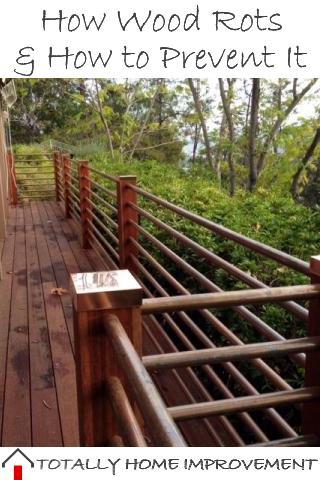
Finally your new porch is done. Your hard work is about to pay off both aesthetically and financially as home improvements add to your home’s value. You’re proud of your work. Are you taking steps to protect it? No?! You really should. While it’s true that home improvements will add to a home’s financial value, damages to any part of your property will highly downgrade its value. Unprotected fences, posts, or beams will start to rot and bleed out money. What exactly happens when wood starts to rot? How can projects and money be protected? Let’s find out!
We know dead wood and water don’t mix. As a result water and your new porch aren't going to get along. Water by itself however isn't going to result in rotting. Moisture however creates a perfect habitat for some of Earth’s oldest creatures, fungi! Moist environments are like Shangri-La to fungi. That’s why it’s important to dry your feet after taking a shower unless you like athlete’s foot, but I digress. Like some people, fungi are picky eaters and that creates different types of rot. Not all rot is created equal!
Brown rot is one type of wood rot that strikes unprotected wood. The fungi that cause this type of rotting love to eat hemicellulose. This is one of the molecules that give wood its shape and is mainly composed of sugars1. Took you back to high school science, huh? While catering to its sweet tooth brown rot causing fungi release hydrogen peroxide which breaks down cellulose, the main molecule that gives wood its structure. The release of this chemical leads to the wood shrinking and getting a brown color. The wood also starts to split into crumbly cubic shapes. Brown rot is one of the most common types of rot that affects homes.
White rot is another common type of damage that can affect unprotected wood. The bacteria that cause this type of damage can be described as the hard-partiers as they tend to mainly break down the lignin in the wood. Lignin is an aromatic alcohol polymer that fills the spaces between cell walls2. By breaking down lignin these fungi cause the wood to feel moist, soft, spongy, or stringy. As the type of rot implies these fungi make the wood take a whitish or yellowish appearance. The white coloration should not be confused with dry wood which is a complete different damage that is caused by the sun and not by a fungus.
Both of these wood damaging rots can cause headaches as repairs quickly add up to your new projects. Wood itself can show signs of rotting within months, sometimes even weeks. That is why it is important to protect your home improvements as you would with any investments regarding your home. The obvious answer to protect wood from rotting is of course limiting or eliminating its exposure to water. Take away fungi’s home, take away fungi. Simple.
The main thing that needs to be done is to protect your fences, posts and beams. One idea is to use sealant on not only these but all wooden products. Sealant works by penetrating the wood’s pores and preventing water from entering and pooling inside the wood. Like the saying goes, “Don’t put your eggs in one basket,” sealant is not the end-all solution to prevent rotting. Sealant must be applied once there is no moisture inside wood. While the outside looks dry, the inside might still contain moisture. Putting sealant on wood in this condition will not protect it. Also sealants are at the mercy of the elements and will be worn off eventually. The other side of protecting your home improvement products are sheet metal caps. All caps work by isolating the beam, post etc. from water. During precipitation water pools on top of the post or beam and often start to rot from the top down. Caps shelter and protect the top and let’s water pool on the cap and not the wood. Caps also shed water away from the beam or cap therefore limiting water exposure.
Together sealant and post/beam caps provide the perfect one-two punch to rot! Together they help your wooden projects avoid becoming fungi’s paradise. The rotting that fungi causes destroys your hard work in a short amount of time and leads to a significant lighter wallet. Prevention is cheaper than repairs and when it comes to post and beam caps we make prevention look wonderful!
Say no to rot!
You might also like to read:
• How To Store Timber
• 5 Eco-Friendly Fencing Options for Your Home
• How To Remove Mould Stains From Wood Floors
• The Great Debate - Deck Versus Patio
References:
Category:




